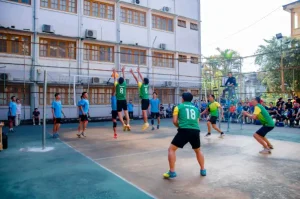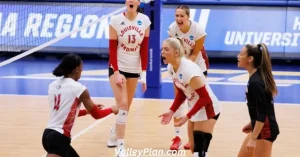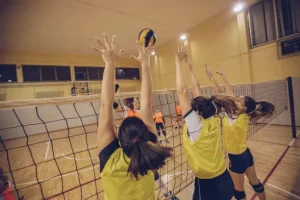Defensive volleyball drills are exercises designed to enhance players’ skills in defensive aspects of the game, including techniques for digging, blocking, and overall court coverage.
These drills focus on improving players’ ability to receive and control the ball, react quickly to opponents’ attacks, and work collaboratively to strengthen the team’s defensive strategies.
Volleyball Defense Drills For Beginners
If you’re new to volleyball, start with fundamental defense drills. Focus on proper stance, movement, and basic digs to build a strong foundation. Practice controlled passes to ensure accuracy and control during defensive plays.

Middle School Volleyball Defense Drills
As players progress to middle school, introduce more dynamic defensive drills. Emphasize teamwork and communication while refining techniques like blocking and digging. These drills enhance individual skills while fostering cohesion among teammates.

High School Volleyball Defense Drills
High school volleyball demands a higher level of skill and coordination. Implement advanced defensive drills that challenge players to react quickly, make strategic decisions, and strengthen their overall defensive capabilities.
Work on blocking strategies, dive-and-roll techniques, and rapid transitions to prepare for competitive play.
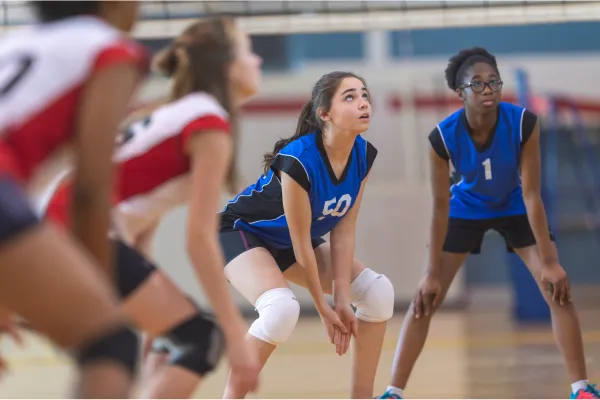
Importance of Defensive Volleyball Drills
Why Defensive Skills Matter
Before we delve into specific drills, let’s understand why defensive skills are crucial in volleyball. A robust defense prevents the opposing team from scoring and sets the stage for successful counterattacks.
By mastering defensive drills, players can significantly impact the outcome of a match.
Here are some essential footwork fundamentals in below:
| Drill | Description |
|---|---|
| Lateral Shuffle Drill | Solid footwork lays the foundation for effective defense. Begin with the lateral shuffle drill to improve your lateral movements and court positioning. Maintain a low stance, shifting side to side along the baseline. This drill enhances agility, a key component of successful defensive play |
| Forward-Backward Drill | Incorporate the forward-backward drill to enhance your ability to cover the court. Move quickly between the net and the baseline, focusing on rapid direction changes. This drill simulates real-game scenarios, improving your responsiveness to varying ball trajectories. |
| Footwork Fundamentals | Mastering the basics of footwork is crucial for high school players. Start with lateral shuffles to improve agility. This drill enhances players’ ability to move swiftly across the court, ensuring they are always in the right position to make a play. |
| Reaction Time Training | High-speed reactions are essential for effective defense. Incorporate partner drills with random ball tosses to different court areas. This sharpens reaction time and simulates real-game scenarios, preparing players for unpredictable situations. |
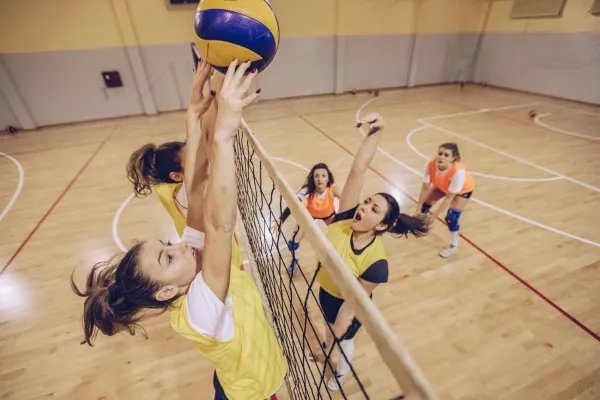
Tips for Effective Defensive Drilling
To maximize the benefits of your defensive drills, consider these tips for optimal training sessions and continuous improvement.
Forearm Passing Mastery
Effective digging is a cornerstone of solid defense. Hone your digging skills through forearm passing drills. Work with a partner to ensure controlled passes in different directions. This drill improves accuracy and develops muscle memory for consistent digs during matches.
Dive and Roll Technique
Expand your reach with the dive and roll drill. Simulate diving for balls that seem out of reach, followed by a controlled roll to minimize impact. This drill sharpens defensive skills and aids in injury prevention during dives.

Incorporating Game-Like Scenarios
To truly simulate the pressure and unpredictability of a match, integrate these game-like drills into your training routine.
Blocking Agility Challenge
A strong defense often involves effective blocking at the net. Develop your blocking agility with lateral jump drills along the net. Emphasize proper hand positioning and quick lateral movements to stop the ball effectively.
This drill enhances both timing and positioning during a game.
Team Communication Exercises
Communication is the backbone of a cohesive defensive unit. Implement drills focusing on verbal and non-verbal communication between teammates—practice calling out the ball’s location and signaling intentions, fostering a collaborative and well-coordinated defense.
Advanced Defensive Techniques:
Reaction Time Elevation
Enhancing your reaction time is paramount for effective defense. Engage in partner drills that involve rapid ball tosses from varying angles. React swiftly and move decisively toward the ball’s location, mimicking the unpredictable nature of actual game scenarios.
This drill sharpens reflexes and conditions you to anticipate and respond swiftly to changing situations.
Dynamic Serving Under Pressure
Simulate high-pressure serving situations to fortify your defensive capabilities. Design drills that require you to hit specific targets with your serves.
This exercise enhances your serving accuracy and conditions you to perform under pressure, a skill vital for maintaining a solid defense during competitive matches.
Strategic Defensive Game Plan
Defensive drills are not just about physical conditioning; they also contribute to building a strategic mindset. Understanding your opponent’s patterns and tendencies is key to a robust defense.
Encourage your team to analyze opposing teams’ gameplay to anticipate shots, making your defensive efforts more proactive and effective.
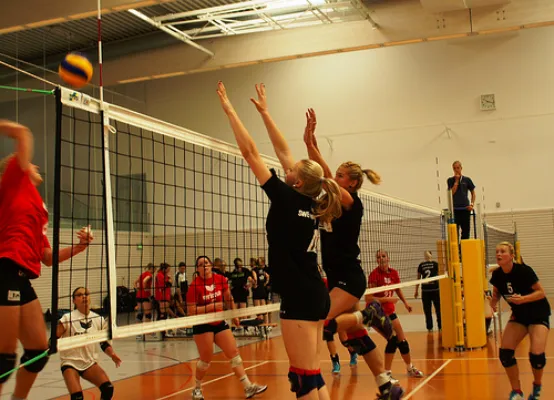
Consistency And Progress Tracking
Monitoring Improvement
Establish a consistent train:
- Establish and monitor your performance to ensure continued progress.
- Eep a training journal to track improvements in footwork, reaction time, and overall defensive capabilities.
Regularly reassess your strengths and areas for improvement, adapting your training regimen accordingly.
Injury prevention Measures
While pushing your limits in training is essential, prioritize injury prevention. Incorporate warm-up routines and cooldown exercises into your training sessions to maintain flexibility and reduce the risk of injuries, particularly during high-impact drills like diving and rolling.
Team Integration and Unity
Defensive success extends beyond individual skills; it’s about creating a unified defensive front. Foster a team-oriented mindset through collaborative drills that require seamless coordination.
Team-building exercises strengthen bonds and translate to a more cohesive and effective defensive unit on the court.
Adapting Drills for Varied Skill Levels
Tailor your defensive drills to accommodate players of different skill levels. Encourage a supportive environment where advanced players can mentor beginners, fostering growth and improvement across the team.
Inclusivity in training promotes a positive group dynamic and ensures everyone contributes to the defensive strategy.
FAQs
To improve as a defensive player in volleyball, focus on mastering proper digging and passing techniques. Enhance your agility, positioning, and anticipation skills to react quickly to opponents’ attacks.
Preventive Defense: Focuses on avoiding the occurrence of a threat.
Detective Defense: Involves identifying and responding to threats once they occur.
Corrective Defense: Aims to restore systems to normal after a threat has been addressed.
When playing volleyball, base defense is the defensive formation where players stand near the back edge of the court to take hard hits from the other team. It gives you a strong base to protect yourself from strong spikes.
Most volleyball defense is played near the sideline in the back of the court. In defensive positions, players try to take the other team’s attacks and control them so that they can launch a good counterattack.
Denial: Ignoring or refusing to accept a threat.
Avoidance: Steering clear of potential risks.
Reduction: Minimizing the impact or likelihood of a threat.
Transference: Shifting the risk to another party.
Acceptance: Acknowledging and enduring a certain level of risk.
Deterrence: Discouraging potential threats through warnings or consequences.
A 5-1 rotation in volleyball is a way of switching between players where one player stays in the setter position the whole game and the other five players take turns playing both offense and defense.
Conclusion
In conclusion, mastering defensive volleyball drills is a journey that requires dedication, strategy, and teamwork. Each drill contributes to a holistic defensive skill set from fundamental footwork to advanced techniques.
Remember, consistency and adaptability are key. Regularly reassess and refine your training regimen to keep pace with your evolving skills and game dynamics.
By integrating these drills into your routine and adopting a strategic mindset, you’re not just improving your defense but elevating the entire team’s performance on the volleyball court.
Stay focused, stay agile, and watch as your commitment to defensive excellence transforms your game. Incorporating these defensive volleyball drills into your training routine will undoubtedly elevate your skills on the court.
Consistency is key, so make these drills a regular part of your practice sessions. Focusing on footwork, reaction time, digging techniques, and teamwork will make you a formidable force in volleyball defense.
Strengthen your foundation, stay agile, and witness how your defensive prowess positively impacts your overall game. Whether you are a beginner or an experienced player, mastering these drills will undoubtedly contribute to your success on the volleyball court.
Related Posts
What is pepper drill in volleyball
Conditioning drill in volleyball
perimeter defense in volleyball
When does volleyball season Starts
Can You Use Your Head In Volleyball?

Hassan Baig a former volleyball player, coach and Administrative At Volleyplan.com.
My name is Hassan Baig and I am a former volleyball player and coach. I have a passion for the sport and have dedicated my life to promoting it. I have worked with some of the best players in the game and have helped them achieve their full potential Read More


